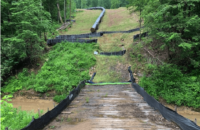California is taking steps toward a 2024 start of construction on the 1.5-million-acre-feet Sites Reservoir thanks to new funding.
The California Water Commission in December determined the Sites Reservoir, located on the west side of the Sacramento Valley, is eligible for funding through the state's 2014 voter-approved Proposition 1 Water Storage Investment Program, thereby opening access to $800 million, about 20% of the project's $3.93 billion price tag.
The Sites Project Authority, originally formed in 2010 and with 30 backing agencies, will continue environmental reviews and permitting—expected to complete in the next six to nine months—followed by critical permits and water rights in mid-2023. Construction is estimated to begin in mid-2024, finished design in 2025 and an operational reservoir by 2030.
"We need to do something, otherwise things are going to get worse," says Jerry Brown, executive director of the SPA, of the state's water crisis.
The Sites Reservoir will capture and store stormwater flows from the Sacramento River—after all other water rights and regulatory requirements are met—to save for release in dry and critical years. By not relying on snow melt, and, instead the rainfall from extreme events, project backers say it will improve the resiliency of water supplies and water supply flexibility while increasing Northern California's water storage capacity by 15% as water reservoir levels around the southwest and California sit at all-time lows.
The backing of Sites has gained momentum thanks to the off-stream design. Add in its location to provide flexibility with the water system in the region, not being another snowpack-related reservoir and ability to provide an environmental benefit by allowing operators to move cold water where it is needed for fish health, and the funding mechanisms needed to push Sites forward have started to take shape.
Matt Swanson, vice chair of the California Water Commission, says he believes "there is nothing more important right now than building out properly vetted water-storage projects that will serve our state and its citizens for generations to come."
The off-stream solution diverts the runoff from the Sacramento River into the Sites Reservoir project without damming or impeding the river's flow, instead pumping water into the reservoir. By adding over 250,000 acre-feet of cold-water pools, Sites says it can improve habitat for salmon while benefiting water conditions.
Sites Reservoir sits close to Shasta Lake, Lake Oroville and Folsom Lake, meant to serve as a complementary option to the existing elements of statewide water management to create flexibility and adapt to changing river and Delta management conditions. For example, Sites operations can coordinate with Shasta Lake to reserve cold water for endangered salmon in the river or contribute to the increased fresh-water flow into the Delta during drier periods to assist with salinity management. Sites would not compete for the water resources stored in these facilities but increase the total amount of storage. Water from Sites can serve environmental benefits while supporting agriculture, residential and business needs, backers say.
Sites requires about 180 miles of conveyance, the space to store the water and move it in and out of the river. "What is most interesting is about 12 miles is new, the remainder is all existing," Brown says. "That is a very critical aspect to making off-stream storage work cost-effectively, having it located in proximity to the water source and the use of water."
The site spans areas with tribal concerns about historical artifacts and burials. A group of two dozen tribal and environmental groups expressed concern over the project, citing additional stress on the salmon population. Doug Obegi, director of California river restoration for the National Resources Defense Council, says "excessive water diversions will harm salmon and other native species" by disrupting river flows needed for juvenile salmon.
Pit River tribal member Morning Star Gali, working with the nonprofit Save California Salmon, wrote that with over 1,000 reservoirs in the state, a new reservoir represents an "environmentally destructive … step in the wrong direction."
The U.S. Secretary of the Interior announced in December 2020 that Sites was technically and financially feasible and should receive priority for federal investment. Sites Reservoir is billed as both a water resiliency project and an environmental project by allowing the system to store more cold water near Shasta for necessary salmon spawning in the spring and summer months. The determination of the environmental benefits of the project could maximize the federal contribution on the project to 25% of the overall cost. Possible sources of federal money for the project include the 2016 Water Infrastructure Improvements for the Nation Act (WIIN Act) and the Infrastructure Investment and Jobs Act of 2021.
The remainder of the project cost will be paid for by water and irrigation districts participating in the project, spanning as far south as the Coachella Valley and Los Angeles, and as far north as Plumas County.
Contractors that have worked on the project at some level so far include AECOM, Jacobs, ICF International, Fugro, HDR and Brown and Caldwell.





Post a comment to this article
Report Abusive Comment